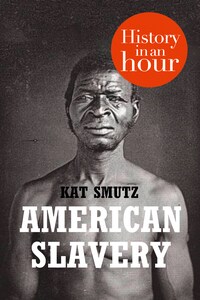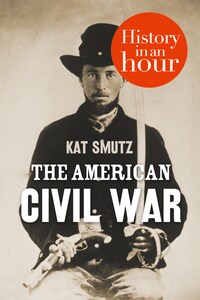AMERICAN SLAVERY
History in an Hour
Kat Smutz
About History in an Hour
History in an Hour is a series of ebooks to help the reader learn the basic facts of a given subject area. Everything you need to know is presented in a straightforward narrative and in chronological order. No embedded links to divert your attention, nor a daunting book of 600 pages with a 35-page introduction. Just straight in, to the point, sixty minutes, done. Then, having absorbed the basics, you may feel inspired to explore further.
Give yourself sixty minutes and see what you can learn …
To find out more visit: http://historyinanhour.com or follow us on twitter: http://twitter.com/historyinanhour
Contents
Cover
Title Page
About History in an Hour
Introduction
The New World
The Middle Passage – the Atlantic Slave Trade
The Human Cargo
Welcome to the New World
Non-Existent Rights
The Abolitionists
The Concept of Freedom
The Educated Slave
The Beginning of the End
North v. South
‘Manifest Destiny’
Uncle Tom
John Brown
Abraham Lincoln
Secession
The American Civil War
The End of Slavery in the US
Appendix 1: Key Players
Appendix 2: Timeline of American Slavery
Copyright
Got Another Hour?
About the Publisher
Introduction
When the first African slaves arrived in North America, there were no states to unite, much less a United States. There was only Jamestown, and the only form of slavery was indenture. As more and more colonists arrived, and as the country grew and spread and evolved, so did the institution of slavery. Along with it came a division in America’s way of thinking. While some became more and more reliant upon what became known as ‘our peculiar institution’, others began to question the morality of slavery. By the time Thomas Jefferson drafted the Declaration of Independence, slavery was a practice that was beginning to draw more and more attention. In the North, states would begin to outlaw slavery one by one, as the agrarian South would become more and more dependent upon it. And as the country expanded towards the west, American’s lawmakers would be faced with the task of determining how to go about adding new states, and how to determine if those states could or could not own slaves.
Meanwhile, the rights of slaveholders would overshadow the barbarity of slavery and those who opposed slavery would thumb their noses at the law in order to assist fugitive slaves along the famous Underground Railroad.
Controversy would turn to violence and resentment would smolder until the election of a president who openly opposed slavery fanned the embers into the flames of war. Less than one hundred years after fight for freedom from Great Britain, the enslavement of African-Americans would grow into a controversy that would divide the United States and threaten to tear the fledgling nation asunder.
This, in an hour, is American Slavery.
The New World
In 1492, an explorer from Genoa in Italy named Cristoforo Colombo, better known as Christopher Columbus, proved that the ocean did not spill over the western horizon into an endless chasm of space, as had previously been assumed. Instead, he found land, untouched, brimming with resources, and filled with potential for expansion and profit. He soon established a colony on the island of Hispaniola, where sugar cane proved a profitable crop. But it was a crop that was labour intensive and men were needed to work the fields. The colonists, who had claimed the islands in the Caribbean as their own, reached out to the Portuguese who, in their travels along the west coast of Africa during the fifteenth century, had been buying Africans as slaves, shackling and transporting them across the world.
Christopher Columbus, painting by Sebastiano del Piombo
The European superpowers of the day – England, Spain, France, Portugal and Dutch (as Germany was informally known at the time) – all began to covet this new land, this new place, this New World and its potential for profit. Some were financially bankrupt from years of war, ill-advised spending, or both, and they sent expeditions funded by European backers to explore the New World, looking for everything from natural resources to legendary cities filled with treasure. They found a land that seemed limitless in its potential to bring financial gain to their backers, as well as expansion and power for their rulers. Soon, the European superpowers realized that to hold on to their claims in the New World, they needed more than profiteering expeditions. They needed colonization.
There were those who were willing to risk the long sea voyage for the chance to carve out a new life in a new land. But once they arrived they discovered that the dangers did not end at the shoreline, and even the most experienced of the early colonists found it difficult, sometimes impossible, to overcome the hardships of carving a civilization out of nothing. The place was inhabited by natives whose prior claim was ignored and who sometimes took exception to their new neighbours. There were beasts that were unknown in Europe, strange diseases, unexpected weather and any number of other dangers. Taming the New World, even a small portion of it, was not for the faint of heart.









